By Jeffrey A. Rendall, Photos by Scot Rendall
LA QUINTA, CA – It isn’t often you walk off a golf course having struggled mightily and subsequently learn your troubles were exactly what the owners had planned from the beginning, but it’s not every day you see a layout like the PGA West Stadium Course, either.
The late Pete Dye-designed Stadium Course is supposed to be difficult. (Dye died on January 9; he was a great interview and a great man. RIP) That’s right. Whereas most resort course personnel would be apologizing profusely to visitors who complain about the excessive strain caused by their layout, the folks at PGA West are proud of the Stadium’s resistance to scoring. |
|
 |
| The par three 17th hole is another Pete Dye island hole. Intimidating. |
You’ll also be able to tell right off that it was Pete Dye who dreamed up the Stadium course, from its railroad ties, penal bunkers, challenging chipping areas around the greens and the great variety of holes in length and strategy. The course is over 30 years old now, but it’s stood the test of time for constituting a stiff challenge.
Don’t get me wrong – the Stadium Course is not tough because it’s tricky or unfair; the layout is demanding because it requires you to hit good shots (both short and long) on every hole. Having played the course a number of times, it’s much “easier” the second time around -- but that’s only because you’re conditioned to the visual shock after the first jaunt.
Golf architect Lee Schmidt was Pete Dye’s Project Manager on the Stadium Course in the mid 80’s, and he sheds light on how it came to be. “From the initial meetings with the principals of Landmark Land Company (Ernie Vossler and Joe Walser) and Pete Dye, the plan was to build a championship course that would be very difficult and testing to the best players in the world and capable of holding premier golf events.”
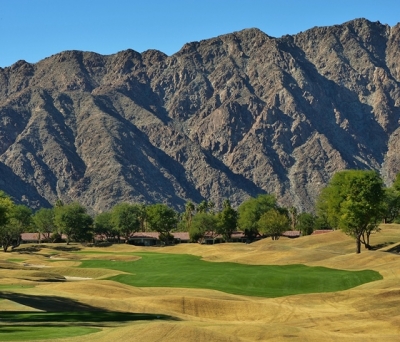 |
| The 471-yard, par four 3rd hole is the first of many muscular par fours on the Stadium Course. |
“Even though the Stadium was the first course to be designed and constructed at PGA West, the original concept was to have the other courses designed by other architects with varying degrees of difficulty.”
With the main principals of the Landmark Land Company being former Tour players and with the group’s association to the PGA of America, the goal was to build a tournament-ready course from the day it opened. Numerous holes were designed with a risk-reward strategy, bold features and spectator viewing areas to accommodate large crowds.
Coming on the heels of the “new” (back then, at least) TPC Sawgrass in Florida, the group wanted to bring the “stadium” concept to the west coast – hence, the name of the course. The developers wanted something that was bold, challenging, memorable and a venue that had a different look than the typical courses that had been built in the Coachella Valley over the years.
 |
| If you end up in the 16-ft bunker to the left side of the par five 16th hole, you might be down there a while. |
Was it Pete Dye on a vengeance? Hardly. But it was clear from the start the Stadium Course had to stand out from the rest. To do that, why not make it really tough? There are more than enough relatively gentle golf courses in the region, so building something hard would definitely set it apart.
To accomplish the difficulty, Dye took the scale of the course to new levels. Quite simply, everything’s big on the Stadium Course. Big bunkers, big lakes, big mounds and even enormous waste areas are found throughout.
One thing it doesn’t have is a tremendous amount of elevation change. The flat desert floor wouldn’t allow for it.
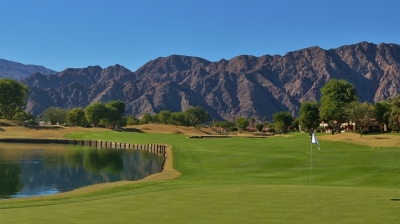 |
| Strategy is the word on the par five 5th hole. |
Schmidt expands on what they found when they first saw the land. “The site consisted of flat farm fields void of any vegetation or natural features that one would consider saving. There was probably only ten to fifteen feet of elevation change through the entire property with the mountain range bordering the property to the west as being the only great asset.”
“The design of the course was routed in two hole corridor loops to allow for increased elevation changes to be made between the holes and increase spectator viewing areas.”
One particularly glaring example of built-in elevation is the signature par three 17th hole – which features an elevated tee and an island green below. Was it supposed to be an exact replica of the 17th at TPC Sawgrass?
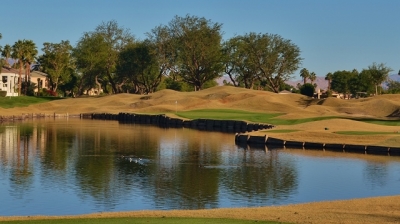 |
| The par three 13th hole has a vintage Pete Dye look to it. |
Certainly not.
“Pete had designed the 17th hole at TPC Sawgrass a few years prior and its success, as a hole that could change the leader board with one errant shot, was a factor,” Schmidt remembers.
“Between the differences in length, a greater elevation change from tee to green and the use of rock around the green and lakes contrasts the design from the Sawgrass hole.”
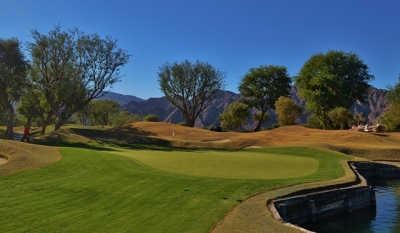 |
| Near the green of the 346-yard, par four 7th hole. |
Schmidt indicated there’s another difference -- the bottom elevation of the pot bunker in front of the green was constructed to be below water surface, so it drains back to hole 16!
The 17th is perhaps most famous for the hole-in-one made by Lee Trevino during the Skins Game in 1987. People still talk about that one.
The history of the Stadium Course is definitely fascinating, but closer to the ground, does it play as hard as the hype? Anthony Holder, Director of Golf at PGA West, says it’s more than just giant bunkers and lots of water that causes problems. “People see the hazards on the Stadium Course and think that’s the only thing making it challenging. But if you’re out there, you realize there aren’t any flat lies, either -- even in the fairway.”
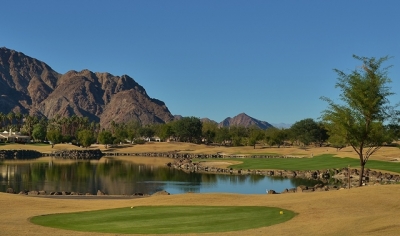 |
| Choose your club wisely off the tee of the par four 10th hole. |
“So you can be facing a big carry over sand or water and you’ve got an uneven lie. That’s a lot to overcome.”
Holder did point out that the course is fairly accessible off the drive, with tees positioned to fairly challenge players of all abilities. Higher handicappers won’t be frustrated by lack of width in the fairways.
The “fairness” in the course was partially due to Alice Dye (Pete’s wife), who always remembers the ladies.
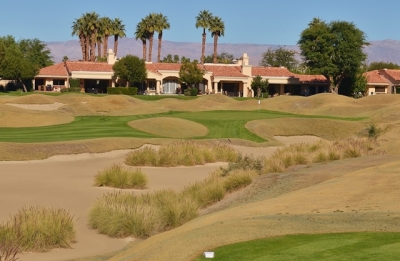 |
| The par three 4th hole is rated the easiest on the front side. |
“Pete would always run his design ideas by Alice,” Schmidt said. “She was always worried about the women and higher handicap golfers, creating a good balance with Pete and his ideas for challenging the best tour professionals in the world.”
Hole highlights include the 535-yard, par five fifth hole (aptly named “Double Trouble”). Players are greeted with a lake that runs down the length of the landing area on the left side and bunkers and rough to the right. The challenge doesn’t let up for the second shot, which introduces a second lake, this time on the right side. How short you want your third shot determines how much lake you’d like to flirt with on your second.
Number six probably takes the prize for most difficult hole, a 255-yard par three that calls for a full water carry unless you bail out to the left. We noticed the drop area had more divots than the tee boxes. This hole alone probably keeps PGA West at the top of the ‘recycled ball’ re-sale category.
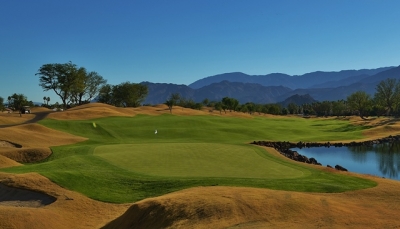 |
| The 617-yard, par five 11th hole is a classic three shotter. |
Nine is the #1 handicap hole on the hardest course in the country, so it’ll test you. 452 yards from the back, there’s water and sand down the entire length on the right, and if you don’t cut off enough of the slight dogleg, your second shot is likely a layup. Deep rough, bunkers and water frame the green. A par on this hole feels like a birdie.
Ten is a crafty medium length par four (416 yards) that calls for water carries on the tee ball and the second shot (a lake runs the entire length on the left and the hole is a slight dogleg left). This time, instead of railroad ties, Dye uses rocks to border the water. A beautiful hole.
Sixteen is a slight dogleg left par five at 566 yards. If your tee ball is left, you’re in an extremely deep bunker that will allow only a pitch to the fairway. Going for it in two isn’t realistic on this hole, even with a booming tee shot. Layup to the right with the second and avoid flirting with the famous bunkers nearer the green on the left with the third.
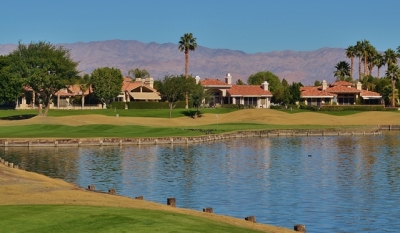 |
| Bailing left is a mighty attractive option off the tee of the long par three 6th hole. |
This hole contributed greatly to the Stadium Course’s reputation. Schmidt elaborates: “When the Stadium Course hosted the Bob Hope Classic slightly over one year from when construction began, there was a major uproar from the pros -- they complained it was too difficult and the slow play was most evident with highlights of Tip O’Neill taking shot after shot from the sixteen foot deep bunker left of sixteen.”
“That was the last time the Hope was hosted on the course, but this incident only increased the play on the Stadium as everyone wanted to try the course that was too tough for the pros.”
As described above, the par three seventeenth hole is named ‘Alcatraz,’ and the moniker suits it. It only plays 168 yards from the tips, but the tee sits up high and the wind blows strong. The green is actually fairly large -- but once again, the size of the lake surrounding the island green makes it appear tiny.
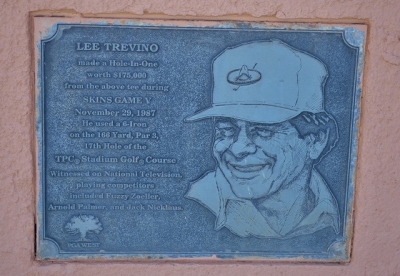 |
| A plaque commemorates the hole-in-one that Lee Trevino made during the 1987 Skins Game. |
The round concludes with another 439 yard tester with water all down the left-hand side. By now, you’re used to it. One great hole after another and the finishing hole is no exception.
Not only is the course noteworthy, so were the conditions and service.
“The agronomy team here at PGA West is unparalleled in the golf industry in my belief,” Holder said proudly. “We have mastered the science of transitioning in/out of two different types of grass a year. We recently won ‘Best Course Conditions’ in Southern California by GreensKeeper.org.”
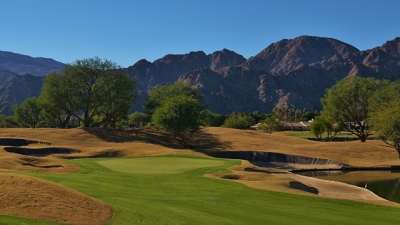 |
| The long par four 9th is the #1 handicap hole on the Stadium Course. |
Holder’s staff was first-rate, making a visit to PGA West easy and enjoyable.
The Stadium Course is a golf experience that should not be missed. Because of the difficulty of the course, it’s not for everyone, but just seeing it is worth at least one visit.
Quite frankly, it’s the toughest examination you’ll ever end up enjoying.
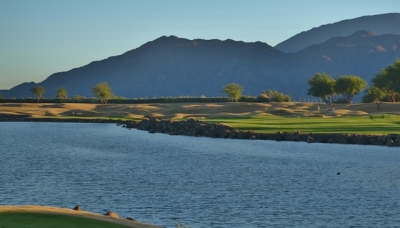 |
| Pick your target and pray off the tee of the tough par four 18th hole. |
Additional Notes from Lee Schmidt on the Stadium Course:
“During the initial design of the project, the developers negotiated a deal with the city to pay one million dollars to have Jefferson Street abandoned where it entered the property. This allowed for a greater flexibility in the land plan and created one of the largest developments to that point in time.”
“Another interesting fact was that during the construction process we were installing dry wells to aid with the drainage. As these were being installed, you could see ground water less than twenty feet below surface. Being in the desert with less than four inches of rain per year, it seemed very uncharacteristic.”
Details:
PGA West Stadium Golf Course
56-150 PGA Boulevard
La Quinta, California 92253
Phone: 1-800-PGA-WEST
Website: www.pgawest.com
Course Designer: Pete Dye
Design Project Manager: Lee Schmidt
Director of Golf: Anthony Holder
Tees/Yardage/Slope/Rating
Tournament 7300 148/75.8
Championship 6739 140/73.1
Combo 6408 136/71.3
Regular 6166 133/70.2
Ladies Rating:
White 6166 143/76.4
Gold 5700 137/73.7
Combo 5400 128/71.9
Red 5092 124/70.2
Rates:
Rates vary from $59 in the summer months, to $229 in our peak season.
Click here to book your tee time for PGA West at GolfNow.
Note: Walking is allowed, and encouraged at PGA West. “You don’t have to be a pro to walk like one” is a great tag line used during the Humana Challenge weeks.
| Related Links | Comments on this article? | |
|
Maryland National Golf Club Hollow Creek Golf Club Rocky Gap Resort PB Dye Golf Club in Ijamsville Whiskey Creek Golf Club |
E-mail Jeff Rendall, Editor: jrendall@golftheunitedstates.com |












